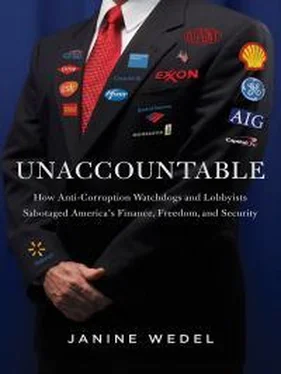116. Matthew Yglesias, “The Glory Days of Journalism.” Slate , March 19, 2013 (http://www.slate.com/articles/business/moneybox/2013/03/pew_s_state_of_the_media_ignore_the_doomsaying_american_journalism_has_never.html).
CHAPTER 6
1. Jack Mirkinson, “Daniel Ellsberg Calls Edward Snowden a ‘Hero,’ Says NSA Leak Was Most Important in American History.” Huffington Post , June 10, 2013 (http://www.huffingtonpost.com/2013/06/10/edward-snowden-daniel-ellsberg-whistleblower-history_n_3413545.html).
2. See, for instance, “Edward Snowden Impersonated NSA Officials: Report.” Huffington Post , August 29, 2013 (http://www.huffingtonpost.com/2013/08/29/edward-snowden-impersonated-nsa_n_3837459.html).
Snowden had worked for another contractor, Dell, before Booz Allen.
3. The three-quarters figure is from government scholar Paul C. Light. In 2008, he calculated that the contract workforce consisted of upwards of 7.6 million employees, or “three contractors for every federal employee.” Paul C. Light, “Open Letter to the Presidential Candidates.” Huffington Post , June 25, 2008 (http://www.huffingtonpost.com/paul-c-light/open-letter-to-the-presid_b_109276.html). See also: Paul C. Light, A Government Ill Executed: The Decline of the Federal Service and How to Reverse It . Cambridge, MA: Harvard University Press, 2008.
The cost of services alone (not counting goods) provided by contractors soared from some $125 billion in 2001 to an estimated $320 billion-plus in 2008. Where once the government procured mainly manufactured goods from the private sector, a huge (and steady) portion of government purchases is now for services that would once have been performed by the civil service.
With respect to the rise in federal dollars spent on contractors’ services: These figures are calculated from data available on the Federal Procurement Data System (FPDS) (https://www.fpds.gov/). While the FPDS database shows the 2001 service figures by category, the 2008 database does not. The total combined figure of goods and services for 2008 is $534 billion. Because procurement spending on services currently accounts for more than 60 percent of total procurement dollars, the $320 billion figure given is 60 percent of $534 (see http://www.fpdsng.com/downloads/agency_data_submit_list.htm). For the assessment that “procurement spending on services accounts for more than 60 percent of total procurement dollars,” see Report of the Acquisition Advisory Panel to the Office of Federal Procurement Policy and the United States Congress , January 2007, p. 3 (http://acquisition.gov/comp/aap/24102_GSA.pdf).
The latest FPDS data in which services are compiled by category are for 2006, and the figure for that year is $244.7 billion. See Federal Procurement Data System, Federal Procurement Report 2006: Section 1 Total Federal Views, pp. 31-32 (http://www.fpdsng.com/downloads/FPR_Reports/2006_fpr_section_I_total_federal_views.pdf). The number was calculated by adding total spending on R&D (p. 31), plus total spending on other services (p. 32). No more recent compilation of these numbers become available after as of July 2009.
[With regard to the portion of government purchases now spent on work previously performed by the civil service: The proportion of services, as compared with total procurement (goods and services) went from 39 percent at the end of the Reagan administration (FY 1988) to 46.5 percent at the beginning of the Clinton presidency (FY 1993) to approximately 60 percent in 2006 (see https://www.fpds.gov/). See also Project on Government Oversight, “Pick Pocketing the Taxpayer: The Insidious Effects of Acquisition Reform, Revised Edition.” March 11, 2002 (http://www.pogo.org/pogofiles/reports/contract-oversight/pickpocketing-the-taxpayer/co-rcv-20020311.html). The 2007 report of the Acquisition Advisory Panel assessed that “procurement spending on services accounts for more than 60 percent of total procurement dollars” ( Report of the Acquisition Advisory Panel to the Office of Federal Procurement Policy and the United States Congress , January 2007, p. 3 {http://acquisition.gov/comp/aap/24102_GSA.pdf}).
While the total dollar value of federal procurement spending has declined since 2011, the proportion of services (including construction) to products has remained constant at about 60 percent. Federal procurement spending for 2013 was $461.3 billion (calculated from figures available at www.usaspending.gov [accessed May 20, 2014]), while spending for services (including construction) was $276.2 billion.
For detailed analysis of and information regarding U.S. government contracting-out, see Chapter 4—“U.S. Government, Inc.”—of Janine R. Wedel’s Shadow Elite: How the World’s New Power Brokers Undermine Democracy, Government, and the Free Market. New York: Basic Books, 2009. For analysis of outsourcing in the national security arena, see Janine R. Wedel’s Selling Out Uncle Sam: How the Myth of Small Government Undermines National Security. New America Foundation, Washington, D.C., August 2010 (http://newamerica.net/publications/policy/selling_out_uncle_sam).
Legal scholar Paul Verkuil additionally discusses the implications of outsourcing government functions in Outsourcing Sovereignty: Why Privatization of Government Functions Threatens Democracy and What We Can Do About It (New York: Cambridge University Press, 2007).
4. Core or “inherently governmental” functions, which the government itself deems so integral to its work that only federal employees should carry them out, are specified in an OMB circular of 2003 (Office of Management and Budget, 2003. “Circular No. A-76 (Revised) to the Heads of Executive Departments and Establishments” on the “Performance of Commercial Activities, May 29, 2003, “B - Categorizing Activities Performed by Government Personnel as Inherently Governmental or Commercial,” A-2, http://www.whitehouse.gov/sites/default/files/omb/assets/circulars/a076/a76_incl_tech_correction.pdf).
5. For a perspective on how the nation’s Founding Fathers (James Madison and others) might have reacted to this state of affairs, based on their writings, see: Janine R. Wedel, “ Federalist No. 70: Where Does the Public Service Begin and End?” Public Administration Review , December 2011, pp. S118-S127.
6. The Wall Street Journal titled a front-page article “Is U.S. Government ‘Outsourcing Its Brain’?” (Bernard Wysocki Jr., “Is U.S. Government ‘Outsourcing Its Brain’?” Wall Street Journal, March 30, 2007, p. A1.)
7. Ingrid Lunden, “Endgame Raises Another $23M to Take its Gov’t Security Solutions to a Wider Commercial Market.” TechCrunch, March 13, 2013 (http://techcrunch.com/2013/03/13/endgame-raises-another-23m-to-take-its-govt-security-solutions-to-a-wider-commercial-market/).
8. James Bamford, “NSA Snooping Was Only the Beginning. Meet the Spy Chief Leading Us Into Cyberwar.” Wired, June 12, 2013 (http://www.wired.com/threatlevel/2013/06/general-keith-alexander-cyberwar/all/).
9. I studied these reports and documents as part of the research for my book Shadow Elite: How the World’s New Power Brokers Undermine Democracy, Government, and the Free Market (New York: Basic Books, 2009) and in a follow-on study (supported by the Ford Foundation), Selling Out Uncle Sam: How the Myth of Small Government Undermines National Security (New America Foundation, Washington, D.C., August 2010). In addition to gathering data from myriad published and unpublished sources, I conducted interviews with government and contractor officials.
10. According to Wired , U.S. annual expenditures on cybersecurity goods and services are approximately $30 billion. Other contractors working in this area, in addition to Booz Allen Hamilton, include General Dynamics, SAIC, Boeing, and Raytheon. James Bamford, “NSA Snooping Was Only the Beginning. Meet the Spy Chief Leading Us Into Cyberwar.” Wired, June 12, 2013 (http://www.wired.com/threatlevel/2013/06/general-keith-alexander-cyberwar/all/).
Читать дальше












